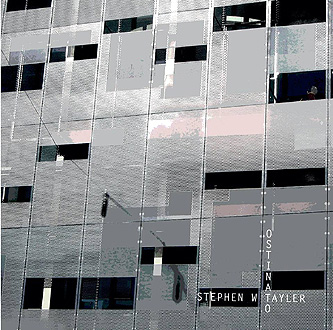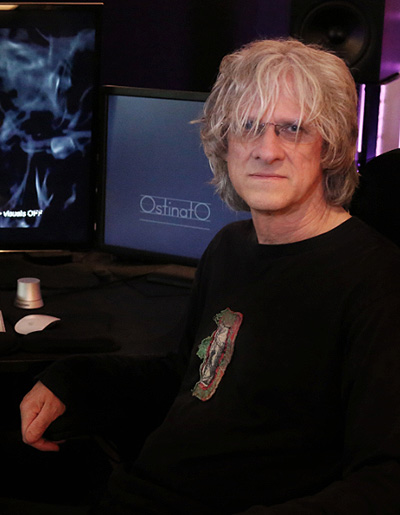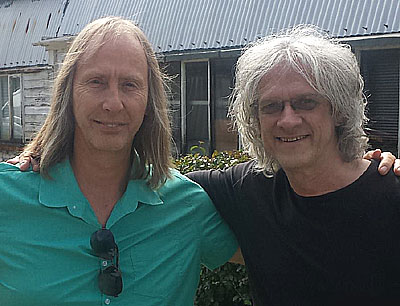 Breaking
down walls for experimental and minimalist electronic music, Stephen
W Tayler makes a statement all his own on the 2015 CD release
of Ostinato. Released on the adventurous Esoteric
Antenna label, the nine track Ostinato sounds influenced by
classic minimalist composers like Terry Riley and Philip Glass, yet
there’s also something of a rock-centric energy on Ostinato.
With a myriad of musical moves, the entire album has a dreamlike
quality to it, a feel greatly enhanced by Tayler's legendary studio
wizardry. Speaking to mwe3.com about Ostinato, Stephen explains,
“These are the sounds and ideas that have lived in my mind...
the sound of voices, choirs, organs, the piano, the clarinet, synthesizers,
vocoders, places and environments, from the depths of my memory and
across the years.
I find it hard to categorize what genre this is... I tend to refer
to it as a blend of minimal electronica, sound design and manipulation
but there are actually many acoustic instruments and voices in there
too.”
A world-renowned mixing and recording engineer, musician, composer
and sound designer, Stephen W. Tayler breaks new ground for 21st century
ambient electronic music with the fascinating sound of Ostinato.
www.StephenTayler.com
Breaking
down walls for experimental and minimalist electronic music, Stephen
W Tayler makes a statement all his own on the 2015 CD release
of Ostinato. Released on the adventurous Esoteric
Antenna label, the nine track Ostinato sounds influenced by
classic minimalist composers like Terry Riley and Philip Glass, yet
there’s also something of a rock-centric energy on Ostinato.
With a myriad of musical moves, the entire album has a dreamlike
quality to it, a feel greatly enhanced by Tayler's legendary studio
wizardry. Speaking to mwe3.com about Ostinato, Stephen explains,
“These are the sounds and ideas that have lived in my mind...
the sound of voices, choirs, organs, the piano, the clarinet, synthesizers,
vocoders, places and environments, from the depths of my memory and
across the years.
I find it hard to categorize what genre this is... I tend to refer
to it as a blend of minimal electronica, sound design and manipulation
but there are actually many acoustic instruments and voices in there
too.”
A world-renowned mixing and recording engineer, musician, composer
and sound designer, Stephen W. Tayler breaks new ground for 21st century
ambient electronic music with the fascinating sound of Ostinato.
www.StephenTayler.com
mwe3.com presents an interview with
STEPHEN W TAYLER
 mwe3:
Can you tell us where you’re from originally and where you live
now and what you like best about it? What are some of your favorite
cities and towns to visit?
mwe3:
Can you tell us where you’re from originally and where you live
now and what you like best about it? What are some of your favorite
cities and towns to visit?
SWT: I was born and grew up in High Wycombe, Buckinghamshire,
UK about 25 miles west of London. I was sent off to boarding schools,
so many of my early years were spent away from home, first in Oxford,
then Shrewsbury. For the last 10 years I have been living in the west
of England, near Bath, and I am now based at Real World Studios, where
I share a studio space with my partner. It is wonderful to be involved
in such a wonderful creative community of musicians, producers and
artists.
I have traveled a lot and been to many great cities, all of which
have their pros and cons. My favorites would have to be NYC, Los Angeles,
Melbourne and Sydney, Rome and Paris, and I enjoy London more now
that I don’t actually have to live there! These are all good
in small doses, but I am always pleased to get back to the relative
peace and quiet of home.
mwe3: How did your new solo album Ostinato take shape?
Tell us about the title and how did working on the other side of the
glass with other artists lead to you to decide to make an album of
your own? Would you describe Ostinato as avant-garde and experimental
music?
SWT: Ostinato came about as a result of ideas that had
been fermenting and evolving in my mind for decades. It really is
the product of my meditations and daydreams, inspired by many, many
hours sitting and waiting in studios working as a sound engineer and
mixer. Most of these ideas really came together during a period of
my life when I was traveling a lot... endless hours waiting in stations
and airports, sitting in trains, planes and automobiles. The themes
in my head began to blend with the sounds around me.
I began to record these sonic environments using in-ear binaural microphones
with a Mini Disc recorder. I would be in a trancelike state in order
to deal with the tedious nature of these journeys, and that is what
inspired me to bring my ideas together in a minimal, repetitive, atmospheric
and hypnotic fashion. Ostinato is the Italian musical term
for a repeating phrase or rhythm. Literally translated it means stubborn
or obstinate. I wanted to create these atmospheres and then add simple
patterns with ever evolving sounds and arrangements.
I find it hard to categorize what genre this is. I tend to refer to
it as a blend of minimal electronica, sound design and manipulation
but there are actually many acoustic instruments and voices in there
too.
 mwe3:
Where and when was the music of Ostinato written and recorded?
How long did it take to write and record and who is Sadia Sadia who
is listed as exec? Who else aided in the completion of Ostinato?
mwe3:
Where and when was the music of Ostinato written and recorded?
How long did it take to write and record and who is Sadia Sadia who
is listed as exec? Who else aided in the completion of Ostinato?
SWT: Many of the soundscapes were gathered during my travels
to and from Paris during the late 1990s, when I was recording and
mixing with Eric Serra, and that is where several of the titles and
ideas originated. Some of the musical ideas were recorded during the
2000s, but the bulk of the writing and reworking started around 2010
and was finished in 2013. I still am very active as a producer and
mixer, so I had to find moments between my other projects.
It was all put together at my then home studio. I reckon the album
in reality took about six months but it's impossible to really measure
it. Some of the ideas were inspired by ideas from when I was a teenager!
It is ever ongoing as I have created a full visual to complement the
music and I have created a surround version as well.
Executive producer Sadia Sadia is my creative partner. We have been
best friends for over 25 years and occasionally collaborate or support
each other’s ventures. We work on a variety of projects that
include many aspects of music, sound, film, visual art and installations
- all manner of time-based arts. Sadia was the only person who gave
me enormously helpful feedback during the making of Ostinato, otherwise
every element of the project was solely down to me.
mwe3: What is your background as a musician? What were your
early music studies like and what instruments do you write your music
with? After listening to Ostinato it seems like you’re
more at home with high tech electronics compared to electric guitars
and acoustic instruments although one listen to the track “On
The Beach” proves you can transfer that music magic on grand
piano.
SWT: I was a boy chorister with New College Choir, in Oxford,
from the age of eight. I studied the piano and clarinet, and eventually
gained a music scholarship to Shrewsbury School. I was fascinated
by recording and pop music, so I picked up other instruments during
my teens. I went on to study music for 3 years at the Royal College
of Music, London. I got involved with all kinds of music from classical
to experimental, and started to play in bands - I suppose heavily
influenced by bands such as Pink Floyd, Soft Machine, YES, Genesis.
On leaving college I decided to get into recording and production,
and so I put my own music making on hold.
 I
would say the most effective part of my music training was in the
choir. That is where I was taught to listen from a very early age,
and that is at the core of everything I do and I count sound itself
as one of my instruments. Much of the musical writing originates in
my head, but when the recording process starts I use whatever is at
hand to get things going, there is never a strict pattern to the process.
For instance, the track “Sacre-Couer” came about by me immersing
myself in the atmospheres that I recorded in the cathedral. It was
about six in the morning and I couldn't sleep, so I went for a walk
and wandered inside the cathedral, and the cleaners were going about
their business... the ambience was marvelous. I am not in any way
religious, but there was a wonderful sense of peace and calm. As with
several of the tracks, I improvised on piano inspired by the recorded
atmosphere and the idea developed from there.
I
would say the most effective part of my music training was in the
choir. That is where I was taught to listen from a very early age,
and that is at the core of everything I do and I count sound itself
as one of my instruments. Much of the musical writing originates in
my head, but when the recording process starts I use whatever is at
hand to get things going, there is never a strict pattern to the process.
For instance, the track “Sacre-Couer” came about by me immersing
myself in the atmospheres that I recorded in the cathedral. It was
about six in the morning and I couldn't sleep, so I went for a walk
and wandered inside the cathedral, and the cleaners were going about
their business... the ambience was marvelous. I am not in any way
religious, but there was a wonderful sense of peace and calm. As with
several of the tracks, I improvised on piano inspired by the recorded
atmosphere and the idea developed from there.
“The Boy Who Said Yes” was an idea I had when I found a
recording of me age thirteen singing the part of The Boy in an opera
by Kurt Weill - Der Jasager (The Yes Sayer). I chose some phrases
of piano and my own voice from the crucial moment when The Boy agrees
to sacrificing his own life in order to save his sick mother... heavy
stuff! Other choral sounds originate from a sonic manipulation of
the other singers.
mwe3: What was it like working with Kate Bush on her last two
albums and on her live shows? How did you meet Kate and what albums
of hers do you like the most?
SWT: I am very lucky to have been working with Kate Bush, who
has become a dear friend, we get on really well. These years have
been very happy for me, the albums were a complete pleasure to mix
with her, and I was honored to be asked to help with the live shows.
It was a first for me to be involved with live sound, complete terrifying,
but I think we cracked it! I was part of a really great team.
Kate is a very private person, and out of respect for her I prefer
to not to talk about our work together.
I was introduced through her manager, who is a long time friend of
mine. My favorite albums of hers would be The Hounds Of Love, which
has become very dear to me especially after Before The Dawn,
and 50 Words For Snow, which has seen her simple long-form
compositions really shine.
 mwe3:
What are some of your other favorite productions and studio work?
I saw that picture of you with Ton Scherpenzeel of Kayak, which was
great. (see left)
mwe3:
What are some of your other favorite productions and studio work?
I saw that picture of you with Ton Scherpenzeel of Kayak, which was
great. (see left)
SWT: I have really enjoyed many albums produced together with
Rupert Hine, so I would pick his solo albums, and many albums made
for The Fixx. A lot of memories are attached to each album I have
been involved in, and it invariably has more to do with the people
than the music. When all the elements come together for an enjoyable
experience and a great piece of work, then that is pure magic. But
too many to mention...
I worked with Kayak right at the start of my career, and I don't have
many clear memories from that time - I was probably so wrapped up
in my new responsibilities and skills! I do remember their fine musicianship
on the album Starlight Dancer. I recently bumped into Ton who
was rehearsing with Camel in the rehearsal room next to our studio
at Real World.
mwe3: I didn’t know you worked on the first two Bruford
albums, which were highly influential. Do you keep in touch with Bill
Bruford? What are your fondest memories of working on the first two
Bruford albums?
SWT: I worked on Bill Bruford’s first two solo albums,
as well as the first album by UK. A lot of my first experiences as
a studio engineer were with some really hot, talented players, many
in the jazz rock fusion world, which made for a really intense atmosphere
in the studio... incredible to witness so much complex music and musicianship
- one had to be really on one’s toes. I had a pretty comprehensive
understanding of music, which really helped and it was noticed by
many of the players. I last saw Bruford in a small club around 13
years ago, it was great to catch up. I do remember the atmosphere
on the albums as being quite tense, but great fun!
 mwe3:
What artists and albums were the most influential to you while you
were growing up and what artists today do you enjoy listening to?
mwe3:
What artists and albums were the most influential to you while you
were growing up and what artists today do you enjoy listening to?
SWT: I really grew up with The Beatles, my older brothers and
sisters had all the records. I used to sit with my brother with a
couple of guitars and play and sing along. The first actual record
I bought myself was “See Emily Play” by Pink Floyd - these
were all very influential. During my teens my tastes became ever more
eclectic, but main influences were The Who, Led Zeppelin, Soft Machine,
Terry Riley and much of early progressive rock. There were a few records
that turned my head sonically - Beatles White Album, Emerson Lake
and Palmer, the first album, and The YES Album. These last
two, produced by Eddie Offord were a very particular and new sound
to my ears. I really listened to a lot of different material, but
I would say that Tubular Bells was also a turning point, and
then when I joined Trident Studios one of the first albums I witnessed
was Crime Of The Century by Supertramp, which has been
a favorite of mine, both musically and production-wise, ever since.
Thank you Ken Scott! These days I don't actually listen to a ton of
music, but my tastes are extremely varied.
mwe3: How did you meet up with Esoteric Records and what do
you like best about Esoteric?
SWT: I was introduced to Esoteric when I helped Rupert Hine
remaster songs for his A&M Trilogy rereleases. Esoteric generally
deals with releasing catalogue by mostly progressive rock artists,
but their imprint, Esoteric Antenna, is all about new material. They
also seem to be branching into more experimental music as well. They
have released material by many of the musicians I have worked with
over the years! And they are lovely people.
mwe3: Tell us about Rupert Hine, how you met him and what are
some of your collaborations with Rupert over the years? What are some
of your favorite Rupert albums and productions? I had forgotten Rupert
was a member of Quantum Jump with John Perry of Caravan.
 SWT:
I first met Rupert Hine in 1976, but in 1980 it happened that we were
managed by the same company, Hit & Run. Our manager suggested
I get together with Roop for his experimental album, Immunity,
we hit it off and the rest is history. We have worked together on
well over 100 projects over the years. Rupert’s four solo albums,
four albums with The Fixx, albums with Howard Jones, Saga, Rush, Stevie
Nicks, Bob Geldof, Tina Turner, Underworld, Suzanne Vega, Milla Jovovich
- so many others too many to mention - a really broad sweep of different
styles and genres. Rupert is always led by passionate and imaginative
song writing, and encourages musicians to stretch themselves and not
just do the obvious. We are so not interested in following trends
and doing the same thing over and over. Not really a mainstream mentality.
It has meant that I have remained quite fresh and enthusiastic over
the years. Always up for new challenges!
SWT:
I first met Rupert Hine in 1976, but in 1980 it happened that we were
managed by the same company, Hit & Run. Our manager suggested
I get together with Roop for his experimental album, Immunity,
we hit it off and the rest is history. We have worked together on
well over 100 projects over the years. Rupert’s four solo albums,
four albums with The Fixx, albums with Howard Jones, Saga, Rush, Stevie
Nicks, Bob Geldof, Tina Turner, Underworld, Suzanne Vega, Milla Jovovich
- so many others too many to mention - a really broad sweep of different
styles and genres. Rupert is always led by passionate and imaginative
song writing, and encourages musicians to stretch themselves and not
just do the obvious. We are so not interested in following trends
and doing the same thing over and over. Not really a mainstream mentality.
It has meant that I have remained quite fresh and enthusiastic over
the years. Always up for new challenges!
mwe3: Now that Ostinato is released and getting great
reviews, what other musical mountains are you ready to scale? Are
you planning on writing and recording new music or are you more interested
in getting back into production?
SWT: Oh, I shall be creating something new when I have the
brain-space. I am ever more intrigued by simultaneously creating audio
and visual works, either as collaborations with others artists, or
on my own. I also have an endless enthusiasm for learning new techniques
and methods.
I already have a theme in mind for the next project. In the meantime
I have a number of ongoing productions to deal with. Watch this space!



